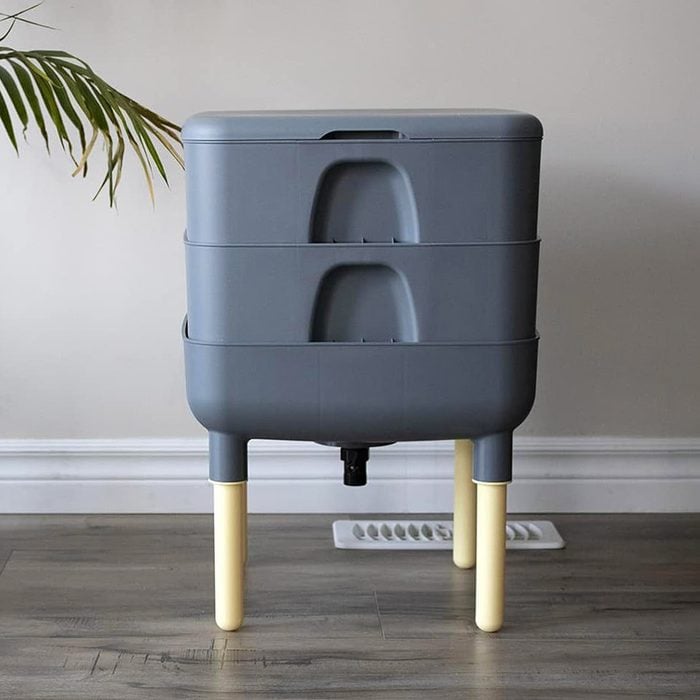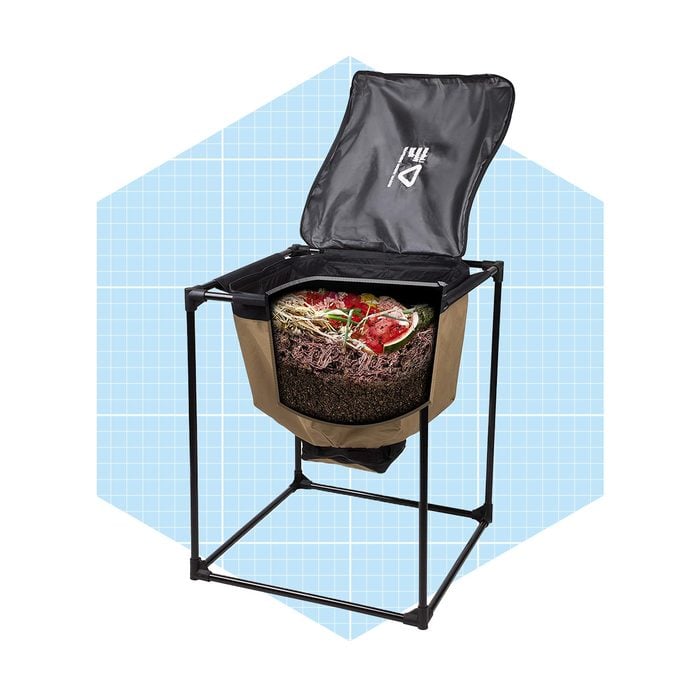
Best Overall Worm Composting Bin
Urban Worm Bag
Besides being my new favorite insult phrase, the Urban Worm bag is a versatile all-star compost factory. It’s quick to set up and easy to maintain because there are no trays. Just put bedding in the bottom, add food scraps and worms up top and wait a few months. As new food scraps are added, the worms migrate toward the top to feed, leaving their castings below. Then, you’ll release the bottom and harvest the bounty.
This system is called a continuous flow through (CFT), which is popular with commercial worm farms because of its efficiency and simplicity and because you don’t have to disturb the worms while harvesting. Once it’s rolling, it can handle 12 pounds of scraps a week. This bin is made for indoor and outdoor use and comes in a few entertaining patterns. The company also offers accessory bundles for purchase.
Pros
- For all experience levels
- Easy-to-use, low-maintenance design
- Can be used indoors and outdoors
- 5.3-cubic-foot capacity
- Breathable fabric to control moisture
Cons
- Can get heavy and hard to move over time
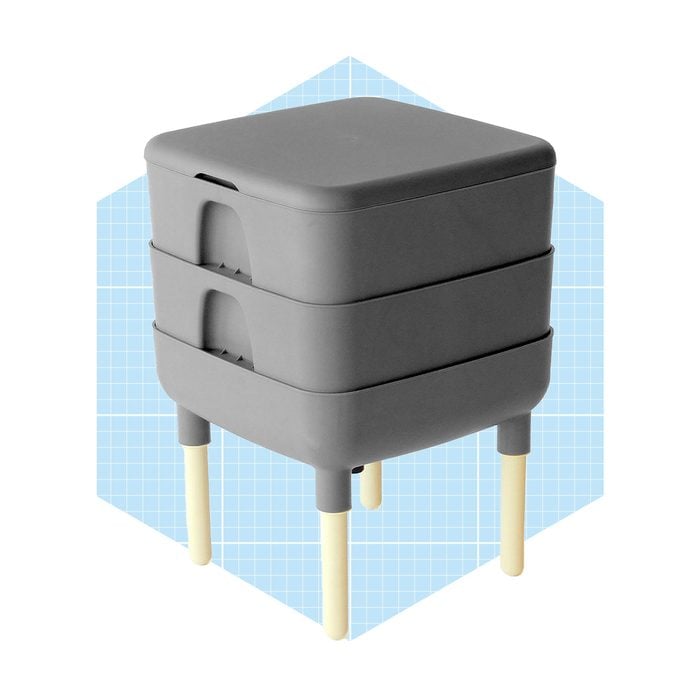
Best Budget Worm Composting Bin
FCMP Outdoor Essential Living Worm Composter
This worm composter from FCMP Outdoor has few frills, but it does have everything you need to get worms to successfully turn your kitchen scraps into fertilizer. It has two stackable trays with moisture channels to keep the bedding moist around the edges, angled tunnels to help the worms move up and down and a spigot to get the worm tea out. It’s made from bisphenol A (BPA)-free recycled plastic and comes in four colors.
“It’s the perfect size for an apartment setup,” reviewer Luna Fortuna explains. “I don’t have a yard, and I have a west-facing porch in Colorado that gets baked, frozen, and wind-beaten by turns. This is small enough to fit in my kitchen under my counter. After 2 months of carefully monitoring this bin, enough worms demolish all our kitchen scraps (it’s just me and my husband) within a couple of days.”
Pros
- Won’t break the bank
- 15-inch-by-15-inch footprint
- Available in four colors
- Has two trays
Cons
- Can’t be used outdoors
- Lower capacity
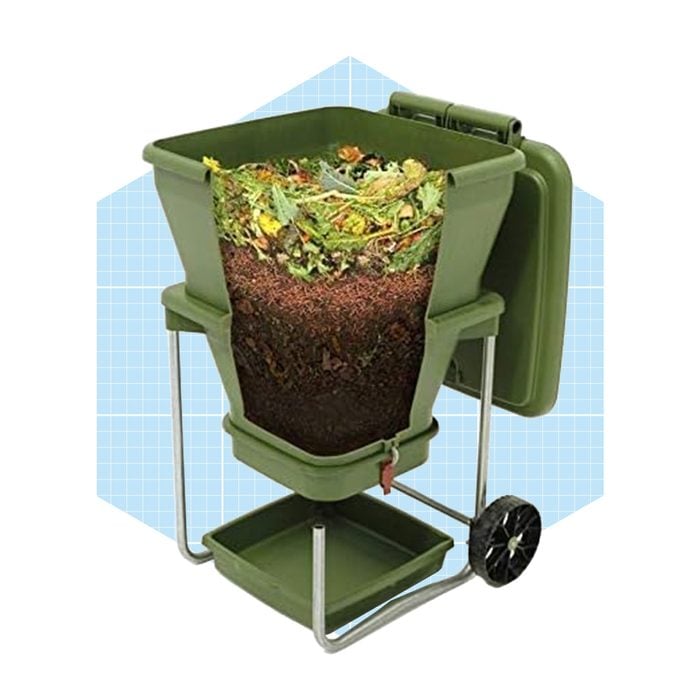
Best High-Capacity Worm Composting Bin
Hungry Bin Worm Farm Compost Bin
The workhorse of worm bins, the Hungry Bin, holds 13 cubic feet of compost and scraps, which equals about 4.5 pounds of kitchen scraps every day. It’s also on wheels, so you can move it into the garage for the winter. Plus, it is sturdy, with an ample seal and latch to keep insects at bay.
Like the Urban Worm bag, the Hungry Bin uses the CFT system, where you put scraps up top and then harvest castings from below. The whole process takes two to four months. When the casting comes out, they’re compressed, which makes them easier to work with. There’s also a filter for the worm tea. It’s made from food-grade polypropylene with organic colorants and includes a five-year warranty.
Pros
- Holds up to 13 cubic feet
- Built to last
- Has wheels
- Easy, efficient system
Cons
- Pricey
- Lacks optimal ventilation
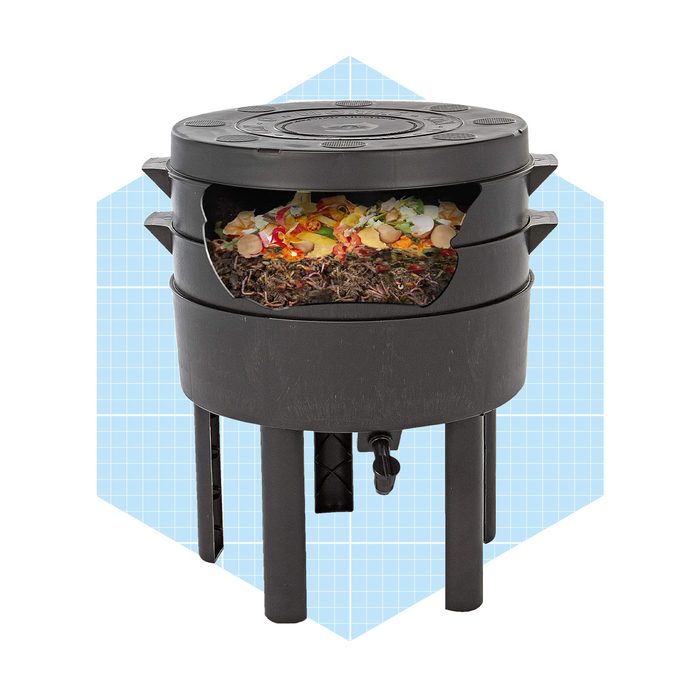
Best Indoor/Outdoor Worm Composting Bin
Tumbleweed Can O Worms
One of the original at-home worm farm manufacturers, Tumbleweed’s Can O Worms is a sturdy option for both indoor and outdoor composting. It is easy to put together, can handle 6 to 9 pounds of kitchen waste a week, has a ventilated lid with a seal to keep out insects and is made from recycled plastic. It’s also one of the few roundworm composting bins out there, which is an ideal shape for small spaces in some homes. The company originally chose the design to help teach kids how to recycle since a rounded shape is more inclusive, inspires learning, and encourages more engagement.
It comes with two large-capacity trays and can be expanded to four. Each tray has a built-in mound, which encourages worms to move from the collector trays to the upper ones. There’s also a tap to drain the worm tea.
Pros
- Designed for indoor and outdoor use
- Good ventilation throughout
- Round design
- Suited for all skill levels, including kids
Cons
- Trays are a little messier than CRT
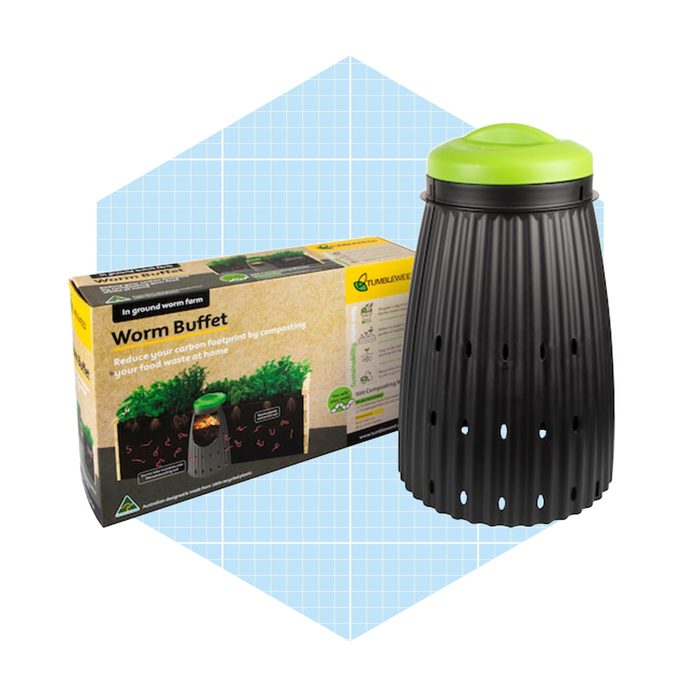
Best In-Ground Worm Composting Bin
Tumbleweed Worm Buffet
Tumbleweed’s in-ground worm buffet is simple and affordable. Just dig a 16-inch-by-16-inch hole in the ground, drop it in, add some moist bedding and food scraps and watch the worms get to work. Well, actually, unlike above-ground worm composters, you won’t be able to watch them work since they’ll be underground. But they will be eating your food scraps and then happily and freely roaming around your garden, spreading castings and aerating your soil.
This worm buffet will process 2.5 to 4.5 pounds a week. There are larger in-ground models available from other brands, but they’re a lot more expensive. If you need more capacity, I’d suggest using multiple ones of this model or just DIYing one. The small size is doubly nice because it saves you the trouble of digging a huge hole.
Pros
- Can fit in most gardens and raised beds
- Budget-friendly
- No odor
- Easy to install and no need to empty
- Gives worms more protection from weather
Cons
- Small capacity
- No way to collect compost for elsewhere in the yard
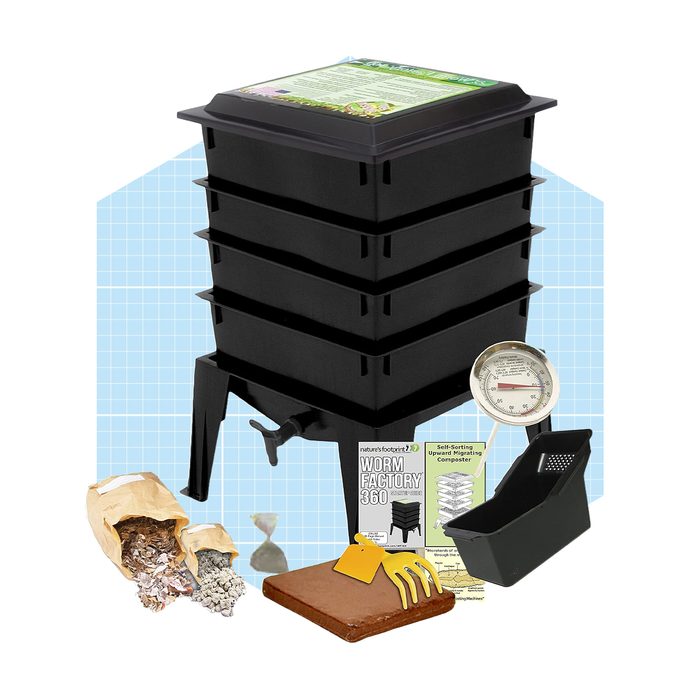
Best Expandable Worm Composting Bin
Worm Factory 360 Composter
The Worm Factory 360 composter is another long-time workhorse product for at-home worm composting. It’s expandable up to seven trays, which makes it a smart option for handling the food scrap load of larger families. That many trays mean it’s a little more complex to set up and operate, but overall, it’s still pretty simple. The stackable design also lets worms move freely from tray to tray, and there’s a spigot at the base for collecting worm tea.
One nice feature of the Worm Factory 360 is that it comes with a starter kit, which includes everything you need, including bedding, a rake and scraper and a worm voucher. It’s made in the United States from recycled plastic and comes with a 10-year warranty.
Pros
- Expands up to seven trays
- Reasonably prices
- Comes with starter kit
- Made in the U.S.
Cons
- Can’t be used outdoors
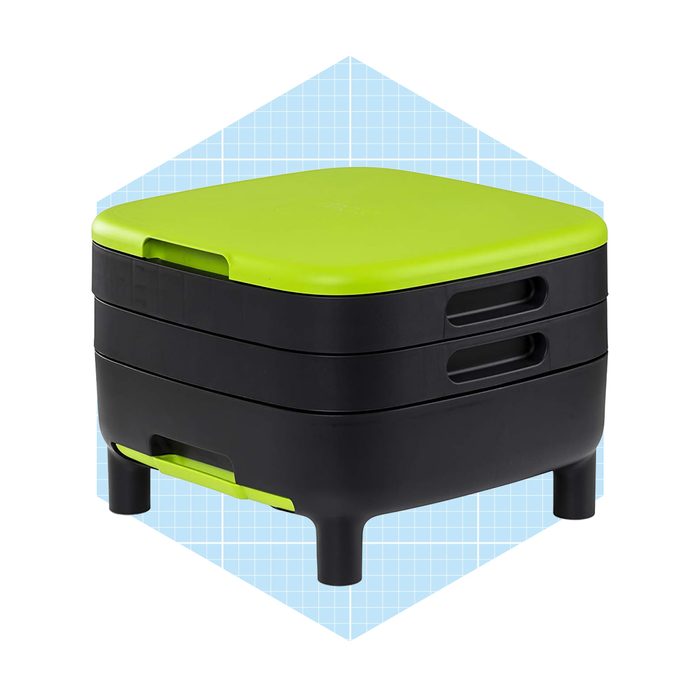
Best Compact Composting Bin
Maze Worm Farm
For those with cramped spaces, like small apartments or balconies, the Maze worm farm is a quality little option. At just 15 inches wide and deep, it can fit nearly anywhere. The two composting trays rotate, and there’s a drip tray to catch the worm tea and a worm-saver tray to ensure the little ones don’t escape out of the bottom. Overall, it’s well made, looks a bit stylish and has legs (sold separately) to make it taller.
“These are great worm composters,” customer Memly explains. “Small and manageable. I can lift it when full to move it around the yard when needed. And they are fairly attractive so I don’t feel like I have to hide them. They are also excellent fun for children to learn about worms and composting. And for them to play with the worms, too. We got one initially and quickly ordered a second.”
Pros
- Fits nearly anywhere
- Weighs just 9 pounds
- Comes with bedding
- Suited for beginners
Cons
- Low capacity
- Pricey
What to Look for in a Worm Composting Bin
The most important factors to consider when choosing a worm composting bin are:
- Space: How much space do you have in your home or garden for a composter?
- Size: How many food scraps does your household typically produce? More people means the need for a larger-capacity system.
- Ease of use: Look at how convenient it is to add food scraps and harvest the compost.
- Location: If you live where it freezes in the winter or where it gets super hot in the summer, you’ll need to bring your worms inside or insulate them with materials. However, this only works to a degree, so choose wisely.
- In-ground vs. above-ground: For outdoor worm composting bins, consider which model you’d like. In-ground allows worms to spread nutrients into the surrounding soil with no effort on your part, but makes the operation immobile. Plus, you can’t harvest the worm castings and tea to use elsewhere in your yard.
Why You Should Trust Us
I was practically born next to a compost bin, and have been exploring my mom’s organic garden since the moment I could walk—and, of course, saving every earthworm I could find on the sidewalk after a rainstorm. Plus, Family Handyman has been working to bring you the best of the best in your home since 1951, so we have years of vetting experience behind us.
How We Found the Best Worm Composting Bins
For this article, we consulted vermicomposting experts and scoured customer reviews to find the best worm composting bins. After examining dozens of options, we narrowed down our search to the top seven picks, based on price, ease of use, practicality and real-life shopper experience.
FAQ
Is worm composting worth it?
Definitely! But it’s not for everyone. There are many benefits of worm composting, and it’s an especially smart way to compost for people with limited space. However, keep in mind that you’ll be responsible for living creatures, and you’ll have to stay on top of their temperature, moisture and food needs. It’s not rocket science, and it doesn’t require a lot of effort, but if you have a particularly short attention span or travel for more than a couple of weeks at a time, then it’s probably not for you.
Is a worm bin better than compost?
It depends on your situation, but theoretically, yes. All composting is a wise move for sustainably disposing of food waste and making nutrient-rich soil for your garden. Because worms also enrich soil with their castings, their soil will likely be more rich in nitrogen and phosphorus than standard compost. Plus, if you have an outdoor, in-ground system they’ll even partly disburse the compost for you.
What is the best worm composter for beginners?
Many people recommend the Urban Worm bag and Maze worm farm for beginners because they’re easy to set up and use. But if you’re just testing the waters, you might want to start with a more budget-friendly setup or DIY your own to see if you like it.
Can I put worms in my compost bin?
Yes, as long as your compost bin has the right conditions for them to survive, including temperature, moisture and pH level. Also, make sure to use the correct worm species. The most common ones used in worm composting are red wrigglers (Eisenia fetida), but if you have local worms, they’ll probably be more hearty. If your compost is outdoors, worms might end up there naturally, either from worm cocoons stuck in soil stuck on weed roots, or because they smelled the food scrap feast and got intrigued.

